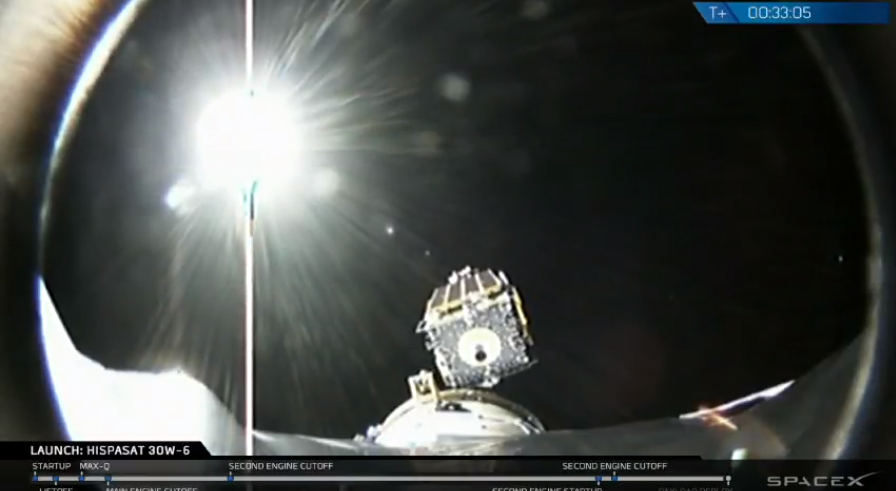SpaceX Launches Hispasat Satellite on Landmark 50th Falcon 9 Flight
SpaceX successfully launched a Spanish communications satellite early today (March 6) on the landmark 50th flight of the company's workhorse Falcon 9 rocket.
The two-stage Falcon 9 lifted off from Florida's Cape Canaveral Air Force Station at 12:33 a.m. EST (0533 GMT) this morning, delivering the Hispasat 30W-6 satellite to Earth orbit about 30 minutes later.
SpaceX commonly lands Falcon 9 first stages during such missions, as part of the company's effort to develop fully and rapidly reusable launch systems. But there was no touchdown attempt this morning. [6 Fun Facts About SpaceX]
"SpaceX will not attempt to land Falcon 9's first stage after launch, due to unfavorable weather conditions in the recovery area off of Florida's Atlantic Coast," company representatives wrote before liftoff, in a description of the Hispasat 30W-6 mission.
As that note indicates, any landing attempt this morning would have taken place at sea, with the booster aiming for the deck of a robotic SpaceX "drone ship." That's the norm for SpaceX launches that involve particularly heavy payloads and those that send satellites to distant orbits; there's often not enough fuel left to get the booster all the way back to terra firma.
And Hispasat 30W-6 meets both of those criteria: It's big, and it's going far afield. If all goes according to plan, the satellite will settle into geostationary orbit, about 22,300 miles (35,900 kilometers) above Earth.
"Falcon 9 flight 50 launches tonight, carrying Hispasat for Spain. At 6 metric tons and almost the size of a city bus, it will be the largest geostationary satellite we’ve ever flown," SpaceX founder and CEO Elon Musk said via Twitter on Monday (March 5).
Breaking space news, the latest updates on rocket launches, skywatching events and more!
The first Falcon 9 rocket launched in June 2010, with two failures occuring over the rocket's nearly 8 years in operation. Those two failures occurred in June 2015, when a Falcon 9 broke apart during the launch of a SpaceX Dragon cargo capsule on a resupply mission to the International Space Station for NASA; and in September 2016, when a rocket exploded on the launchpad during a routine preflight test.
The Madrid-based company Hispasat will use the newly launched satellite for a variety of purposes.
"Hispasat 30W-6 will provide Hispasat additional Ku and C band capacity in Europe, the Mediterranean and the Americas; reinforce the distribution of audiovisual content in Latin America; and provide connectivity in mobile environments," SpaceX representatives wrote in the mission description. "Utilizing the satellite's Ka band transponders, Hispasat 30W-6 will enable Hispasat to expand its broadband service offering in the European region and northwest Africa."
Hispasat 30W-6 was built by California company SSL (formerly Space Systems/Loral) and has a design lifetime of 15 years, SpaceX representatives added.
This morning's launch was originally scheduled to take place Feb. 25, but SpaceX delayed the liftoff to perform pressurization checks on the Falcon 9's payload fairing, the nose cone that protects a satellite during liftoff.
The company then had to wait until after the successful March 1 launch of the GOES-S weather satellite, which lifted off from Cape Canaveral aboard a United Launch Alliance Atlas V rocket.
Follow Mike Wall on Twitter @michaeldwall and Google+. Follow us @Spacedotcom, Facebook or Google+. Originally published on Space.com.

Michael Wall is a Senior Space Writer with Space.com and joined the team in 2010. He primarily covers exoplanets, spaceflight and military space, but has been known to dabble in the space art beat. His book about the search for alien life, "Out There," was published on Nov. 13, 2018. Before becoming a science writer, Michael worked as a herpetologist and wildlife biologist. He has a Ph.D. in evolutionary biology from the University of Sydney, Australia, a bachelor's degree from the University of Arizona, and a graduate certificate in science writing from the University of California, Santa Cruz. To find out what his latest project is, you can follow Michael on Twitter.


